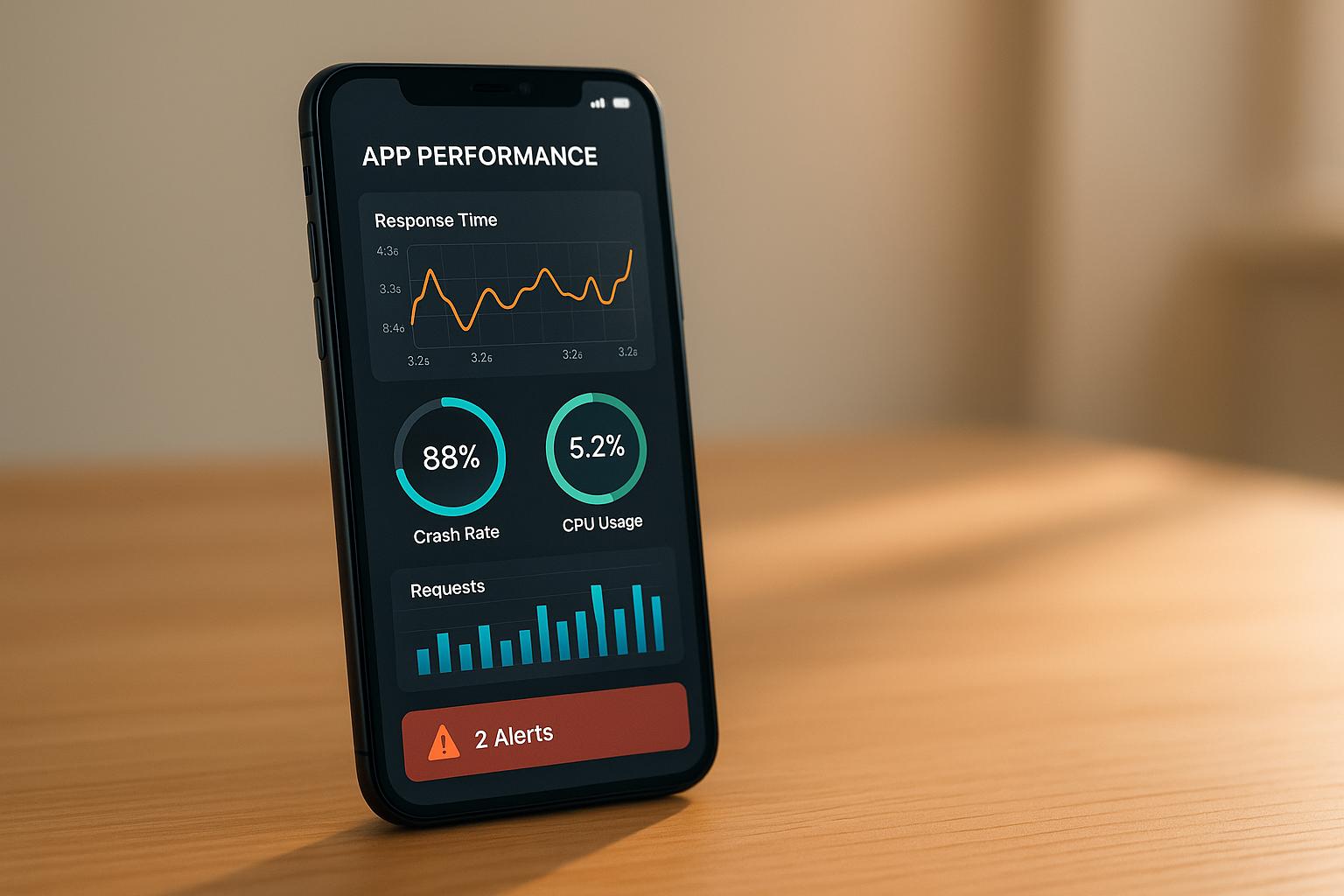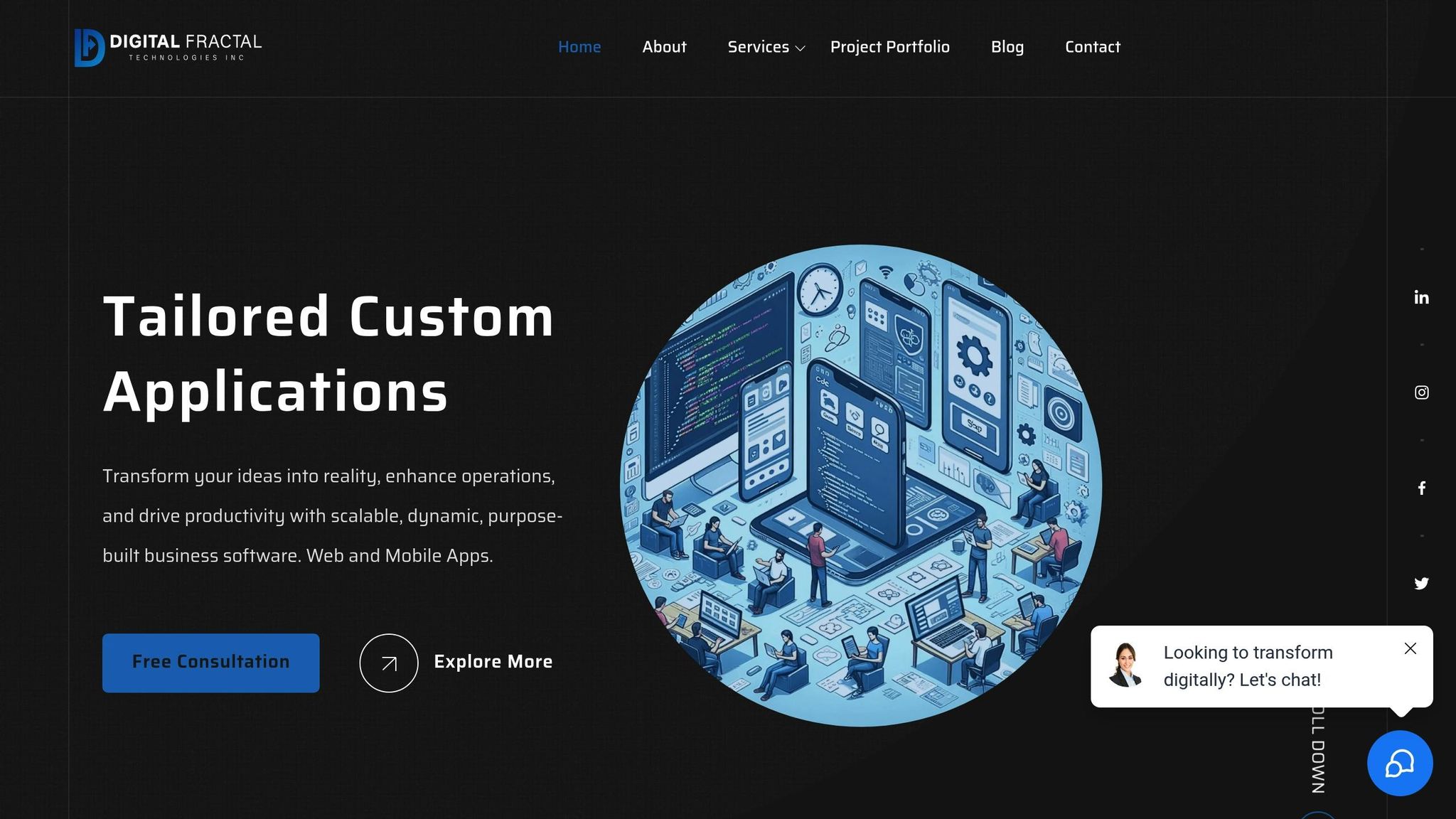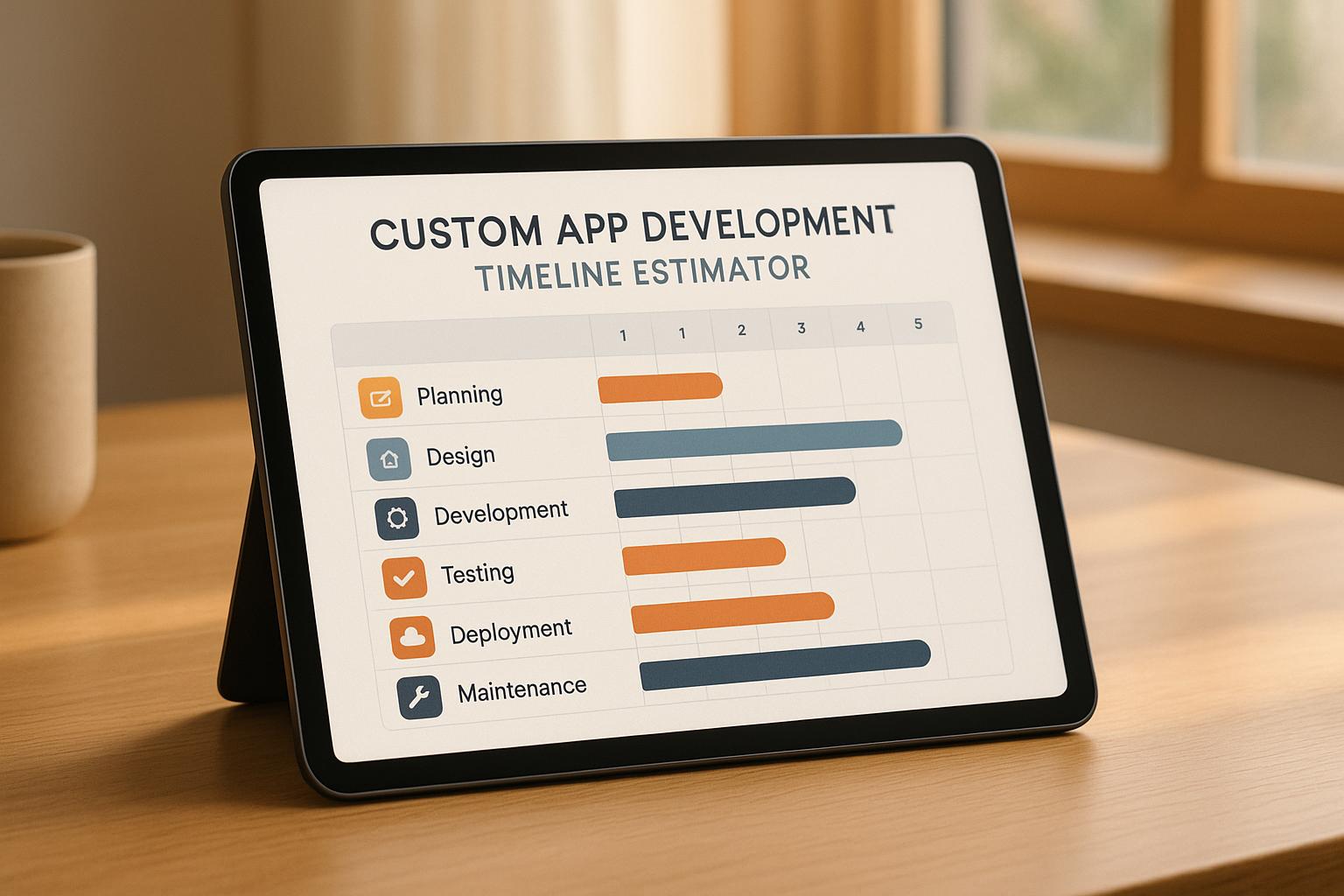
How AI Improves Mobile App Performance Monitoring
AI is transforming mobile app performance monitoring by solving common issues like slowdowns, crashes, and scalability challenges. Traditional methods often fail to detect problems quickly, especially during high-usage periods, leading to frustrated users and lost revenue. AI-powered tools offer real-time insights, predictive analytics, and automated anomaly detection, helping businesses prevent issues before they occur.
Key benefits include:
- Faster issue detection and resolution (up to 60% quicker).
- Reduced false alerts with dynamic thresholds.
- Improved user satisfaction through smoother app performance.
For Canadian businesses, these tools are especially useful in industries like banking, e-commerce, and public services, where reliable apps are critical. AI adapts to regional differences, such as network conditions and bilingual features, ensuring consistent performance across Canada.
Example: A Canadian banking app reduced crash rates from 1.8% to 0.4% in six months using AI tools, improving user satisfaction by 20%. Similarly, a Toronto-based e-commerce platform cut app startup times in half, boosting conversion rates by 15%.
To implement AI-driven monitoring:
- Assess current app performance and identify problem areas.
- Choose AI tools that support features like predictive analytics and real-time alerts.
- Ensure compliance with Canadian privacy laws (e.g., PIPEDA) and localize settings for Canadian users.
AI tools are helping businesses across Canada improve app performance, reduce downtime, and retain users, making them essential for staying competitive in today’s digital landscape.
AI Techniques That Improve Mobile App Performance Monitoring
Anomaly Detection
AI-powered anomaly detection is reshaping how Canadian businesses manage app performance by automatically identifying unusual patterns in real-time data. These intelligent systems learn the typical behaviour of your app and correlate various metrics – like CPU usage, memory consumption, network latency, and user session details – to detect critical deviations.
For example, when a Canadian banking app sees a sudden surge in failed transactions, AI not only flags the issue but also identifies the root cause. Similarly, if your retail app starts using excessive memory during peak shopping periods, such as Boxing Day, AI quickly spots the anomaly and triggers alerts. This proactive approach ensures problems are addressed before they impact thousands of users.
A key strength of AI-based anomaly detection is its ability to adjust thresholds dynamically. Traditional systems might flag a response time exceeding 2 seconds, but AI understands your app’s typical response time – say, 800 milliseconds – and accounts for occasional slowdowns during busy periods. This reduces false alarms while still catching genuine issues.
Building on this foundation, predictive performance analysis takes proactive monitoring to the next level.
Predictive Performance Analysis
Machine learning models enable teams to forecast potential bottlenecks by analysing historical data, shifting the focus from reactive troubleshooting to proactive prevention.
By examining past logs, interaction metrics, and network data, AI predicts and mitigates performance issues. For instance, a Canadian public transit app might use months of data to anticipate slowdowns during the first Monday after a long weekend, when commuter traffic spikes. This foresight allows teams to prepare and avoid disruptions.
AI also helps with infrastructure planning, recommending when to scale server capacity based on predicted demand patterns. Additionally, it identifies gradual performance declines that might otherwise go unnoticed. If your app’s screen rendering time has been creeping up, AI can forecast when it will impact user experience, giving your team time to resolve the issue before it becomes critical.
These predictive capabilities ensure smoother app performance and set the stage for improving user satisfaction.
User Experience Monitoring
AI takes user experience monitoring to the next level by analysing behavioural patterns and user sentiment to optimise app performance. Beyond tracking traditional metrics, it provides insights into how Canadians actually interact with your app.
By studying navigation flows, interaction times, and user feedback, AI pinpoints friction points that might frustrate users. For instance, a Canadian public transit app used AI to analyse navigation patterns and found that Toronto users faced delays during peak hours. The app then improved route suggestions and interface elements, boosting satisfaction and reducing churn.
Sentiment analysis of app store reviews reveals valuable insights for feature updates. For example, users in Vancouver might prioritise different functionalities compared to those in Halifax, allowing for targeted improvements.
AI also enables real-time personalisation based on performance data. If users on older Android devices in rural areas experience slower load times, AI can deliver lighter content or simplified interfaces to maintain usability. This approach ensures consistent performance across Canada, from urban centres with high-speed internet to remote areas with limited connectivity.
Key Metrics and Data Sources for AI-Driven Monitoring
Key Metrics for Mobile App Performance
AI-driven monitoring focuses on critical performance indicators that shape the user experience for Canadians. One key metric is Apdex scores, which measure user satisfaction by evaluating how well an app performs in various regions, from bustling urban centres like Toronto to remote areas in Saskatchewan. These scores give Canadian businesses a clear picture of user satisfaction, especially in competitive markets where expectations are high.
Another essential metric is crash rates, a clear indicator of app stability. Leading apps aim to keep crash rates below 0.5%, as anything above 1–2% can harm your reputation and drive users away. For Canadian apps, this becomes even more critical when supporting both English and French interfaces. Crashes in bilingual features can alienate entire user groups, making this metric especially relevant.
Network latency is a major concern in a country as large as Canada, where delays can significantly impact users in remote or rural areas. Latencies over 100–200 milliseconds can noticeably degrade performance. AI monitoring tools pinpoint these delays and link them to specific regions, helping businesses identify whether users in northern Ontario, for example, face different challenges than those in Vancouver.
UI responsiveness ensures a smooth and intuitive experience across Canada’s diverse range of devices. This metric tracks factors like screen rendering, app startup times, and response times to user interactions. AI systems continuously monitor these areas, flagging performance drops on specific devices or operating systems popular among Canadian users.
Metrics like CPU and memory usage, error rates, and user interaction times also help AI tools identify resource bottlenecks before they impact users.
Real-world examples highlight the effectiveness of these metrics. In 2023, a major Canadian banking app used Dynatrace‘s AI monitoring to cut crash rates from 1.8% to 0.4% in just six months. This was achieved by automating anomaly detection and root cause analysis, which boosted user satisfaction by 20%. Similarly, a Toronto-based e-commerce platform adopted Firebase Performance Monitoring in 2024, reducing its average app startup time from 2.5 seconds to 1.2 seconds. This improvement led to a 15% increase in conversion rates.
These metrics provide the foundation for actionable insights, derived from a variety of data sources.
Data Sources for Effective Monitoring
To deliver meaningful insights, AI-driven monitoring systems rely on diverse data sources that paint a full picture of app health and user satisfaction. One such source is application logs, which capture errors, system events, and user actions. These logs often include details specific to Canadian apps, such as bilingual interfaces and CAD transactions.
Traces are another critical data source, mapping complete user journeys through an app. They reveal how users navigate from login to checkout or from search to content consumption. For Canadian apps, traces may uncover regional differences – users in Quebec, for example, might prefer different navigation flows compared to those in British Columbia. AI tools analyze these traces to identify pain points and streamline user experiences.
Custom events allow businesses to track specific actions tied to their Canadian audience. These might include purchases made in CAD, interactions with bilingual features, or engagement with location-based services. Such events provide detailed insights into user behaviour that broader metrics might overlook.
Real user monitoring (RUM) data captures actual user experiences across Canada, offering a clear view of performance variations between urban areas with high-speed internet and rural regions with slower connectivity. RUM data also highlights how different Canadian carriers affect app performance.
To complement RUM data, synthetic transaction data is used to create controlled testing environments. AI systems rely on this data to establish performance baselines and detect deviations in real-world user experiences.
By combining real-time and historical data, AI-driven monitoring becomes both proactive and reactive. Real-time data allows for immediate issue detection and resolution, while historical data helps AI models identify patterns, predict potential problems, and set dynamic performance baselines.
Digital Fractal Technologies Inc exemplifies how these data sources can be leveraged. They offer AI-driven monitoring solutions tailored to Canadian businesses, ensuring compliance with local regulations like PIPEDA and supporting bilingual environments. Their expertise spans industries such as public services, energy, and construction, helping organizations enhance productivity and maintain operational efficiency.
Reports show that apps with robust monitoring systems experience up to 30% fewer user complaints and 25% higher retention rates compared to those without such systems. This data underscores the critical role of comprehensive monitoring and AI analysis in staying competitive within Canada’s mobile app market.
How to Implement AI-Driven Mobile App Performance Monitoring
Assess Current Performance and Choose Tools
Start by evaluating your app’s current performance using analytics tools to track key metrics like startup times, crash rates, network latency, and user interaction times. This step provides a baseline for comparison and helps identify areas needing improvement. Collect both quantitative data – such as error rates, CPU usage, and memory consumption – and qualitative feedback from users across various Canadian regions to get a fuller picture.
Dive into historical trends to spot recurring problems, like regional network lags or crashes tied to specific features. Pinpointing these patterns will help you determine where AI-powered monitoring can have the most impact.
When choosing tools, look for AI-enabled platforms that offer features like anomaly detection, predictive analytics, and automated root cause analysis. These tools should integrate easily with your existing tech stack, whether your app runs on iOS, Android, or a cross-platform framework.
Keep in mind Canadian data residency requirements. Many businesses must store monitoring data within Canada to comply with privacy regulations. Look for tools that are user-friendly, scalable, and allow you to customize alerts and dashboards. Examples of popular platforms include Dynatrace, New Relic Mobile, and Firebase Performance Monitoring.
Here’s a real-world example: In Q2 2024, a Canadian energy company adopted Dynatrace’s AI-powered APM to monitor its mobile workforce app. By automating anomaly detection and root cause analysis, they reduced incident response times from two hours to just 45 minutes and increased user satisfaction scores by 28%. With the right tools, you can turn raw data into actionable insights.
Integrate AI Models and Configure Alerts
Once you’ve chosen your tools, integrate their SDKs or APIs into your app to start collecting telemetry data. Use historical data to train AI models that enable real-time anomaly detection and event correlation. These models can analyse telemetry data, detect irregularities, and link events across different app components. This process transforms raw data into insights, helping you predict and address issues before they affect users.
Dynamic thresholds, which adapt to normal app behaviour, help reduce false alerts. This ensures that only genuine issues trigger notifications.
Set up automated alerts based on these intelligent thresholds, prioritizing them by severity and impact. Integrate these alerts with tools like Slack or Jira to make sure the right team members are notified quickly. Tailor alert criteria to focus on critical user journeys – such as checkout flows or login processes – so you can address issues that directly affect user satisfaction and business outcomes.
For example, a Toronto-based retail chain implemented Firebase Performance Monitoring in 2023 to track their mobile shopping app. By adding custom traces and setting up real-time alerts, they identified a network latency issue that had caused a 15% drop in checkout conversions. After resolving the issue, their conversion rates improved by 12% within three months.
Don’t forget to retrain your AI models regularly to account for changes in app usage and infrastructure.
Ensure Compliance and Localisation
After integrating AI models and configuring alerts, focus on compliance and localisation to round out your monitoring strategy. Adhere to PIPEDA and provincial privacy laws by storing data within Canada and obtaining user consent. Strengthen your security measures to protect collected data, and conduct regular compliance audits and privacy impact assessments to stay aligned with regulations.
"Boost accountability and data sovereignty with tailored applications that integrate seamlessly into your ecosystem." – Digital Fractal Technologies Inc.
Customizing dashboards to reflect Canadian standards – such as using Canadian dollars, metric units, and date formats like DD/MM/YYYY – makes reporting more relevant and user-friendly. Apply Canadian English spelling conventions consistently to maintain clarity.
Regional filtering capabilities allow you to break down performance data by provinces or territories. This granularity helps identify location-specific issues and variations in user behaviour, providing actionable insights for local teams. Tailoring your approach to these regional differences ensures your monitoring aligns with the diverse needs of Canadian users.
Digital Fractal Technologies Inc, based in Alberta, is a great example of Canadian expertise in this area. They specialize in AI consulting and custom software development for Canadian businesses, particularly in sectors like energy and public services. Their solutions are built to prioritize data sovereignty and compliance while improving operational efficiency.
In October 2020, Digital Fractal Technologies Inc developed a mobile and web application system for Deeleeo, a last-mile delivery service in Canada. This project included creating iOS and Android apps along with a web-based administrative system, showcasing their ability to develop compliant and effective mobile applications for the Canadian market.
"We are a leading Canadian energy service company in the oil and gas sector, and prior to working with Digital Fractal, most of our processes were manual and done by paper." – Regg. M, Operations
This example underscores how implementing AI-driven monitoring – combined with local expertise and a focus on compliance – can lead to real operational improvements while meeting Canada’s regulatory standards.
Benefits and Challenges of AI-Powered Performance Monitoring
Comparison of Benefits and Challenges
AI-powered performance monitoring brings a range of advanced tools to Canadian businesses for managing mobile applications. However, implementing these systems requires balancing the advantages with the hurdles they present.
On the plus side, these systems excel at proactive issue detection, identifying anomalies before they disrupt users. They also offer automated root cause analysis, cutting resolution times by as much as 50%. Another standout feature is their ability to reduce alert fatigue by dynamically adjusting baselines, filtering out non-critical events.
But it’s not all smooth sailing. Setting up AI-driven monitoring can be complex, especially for teams without AI expertise. Integrating AI models and configuring systems often demands specialized technical skills. Additionally, these systems rely on large volumes of high-quality, well-labelled data to deliver accurate results. Without this, predictions can miss the mark, and insights may lose reliability. The following table provides a clear breakdown of these benefits and challenges:
| Benefits | Challenges |
|---|---|
| Detects issues before users are impacted | Complex setup requiring technical expertise |
| Predicts performance using historical data | Needs high-quality, large-scale data |
| Speeds up root cause analysis with real-time insights | Difficult to integrate with older systems |
| Reduces alert noise by up to 80% | Requires ongoing model updates and tuning |
| Enhances user experience, boosting retention | Must comply with Canadian privacy regulations |
| Cuts mean time to resolution by 50% | Risk of false positives during initial training |
| Offers full visibility of app components | Higher costs for advanced tools |
Many organizations have seen strong returns from these tools, including less downtime and better operational efficiency. For instance, a 2023 Dynatrace survey revealed that 75% of companies using AI-powered monitoring reported fewer unplanned outages and a drop in performance-related user complaints.
For Canadian businesses, compliance with PIPEDA (Personal Information Protection and Electronic Documents Act) adds another layer of complexity. This includes strict rules around data residency and user consent. Companies like Digital Fractal Technologies Inc offer support in meeting these requirements while adopting AI-driven monitoring solutions.
To maintain the benefits of AI-powered monitoring, regular updates and human oversight are essential. AI models need to be adjusted as app usage patterns and infrastructure evolve. This includes validating data quality and fine-tuning alert thresholds to ensure the system stays effective over time.
Starting with pilot projects and scaling up gradually is often the best way forward. This approach allows organizations to maximize user satisfaction and operational efficiency while minimizing risks. Combining AI automation with human judgement ensures strategic decisions are informed by both data and context. By weighing the benefits against the challenges, Canadian businesses can fine-tune their mobile app performance strategies for long-term success.
sbb-itb-fd1fcab
Industry Applications and Expertise
Digital Fractal Technologies Inc‘s AI Solutions

Digital Fractal Technologies Inc delivers AI-powered performance monitoring solutions to Canadian organizations in key industries. Their approach combines custom mobile app development with intelligent monitoring systems, designed to meet the operational needs of public sector agencies, energy providers, and construction companies. These solutions aim to connect cutting-edge technology with practical, day-to-day efficiency across Canada.
In the energy sector, the company has achieved impressive results. For one Canadian energy provider, their AI-driven monitoring system cut downtime by 30%. This was made possible by using predictive analytics and automated alerts, which rely on anomaly detection algorithms. These algorithms identify unusual performance patterns before they escalate into failures, allowing maintenance teams to act early and avoid costly disruptions.
Their expertise also extends to field operations where reliability is critical. A prime example is their development of the Xtreme Oilfield mobile application for a leading Canadian energy service company. This iPad-based tool replaced paper forms with digital workflows, automated certificate and permit management, and streamlined job dispatching – all while integrating AI-powered performance monitoring. The system ensured consistent app functionality even in remote areas with unreliable network connectivity, providing a dependable solution for challenging field conditions.
In the construction industry, Digital Fractal Technologies Inc has helped companies achieve noticeable operational improvements. One construction firm reported a 25% drop in support tickets and boosted field productivity after implementing their AI-powered monitoring system. By tracking real-time metrics such as app startup times, crash rates, and user interaction delays, the system enabled rapid troubleshooting, minimizing disruptions on job sites.
When it comes to the public sector, their solutions are designed to meet the strictest compliance requirements, including Canadian data protection laws. Municipal governments, for instance, benefit from their tools that continuously monitor app performance and compliance metrics to ensure adherence to PIPEDA. This not only safeguards sensitive data but also maintains the high availability standards citizens expect from government services. By prioritizing data protection, Digital Fractal Technologies Inc helps build the trust that is crucial for public services and other regulated industries.
Their systems are tailored to Canadian standards, using Canadian dollars, YYYY-MM-DD date formats, and local measurement units. This attention to localization ensures their solutions fit seamlessly into the Canadian market.
Beyond their monitoring systems, the company also provides AI consulting services to help businesses create frameworks for responsible AI use. This guidance is especially valuable when organizations need to balance the benefits of AI with regulatory compliance and data sovereignty requirements, which are particularly critical for Canadian public sector and energy clients.
Digital Fractal Technologies Inc measures success through tangible outcomes such as faster incident response times, reduced operational costs through automation, improved app uptime, and higher user retention rates. Their commitment to continuous monitoring and regular updates ensures their AI systems remain effective as user behaviour and infrastructure evolve.
The company emphasizes the importance of compliance and localization from the start, encouraging collaboration among IT, compliance, and business teams to ensure smooth adoption. This thorough approach allows organizations to enhance user satisfaction and operational efficiency while meeting the specific regulatory and operational demands of the Canadian market.
Beyond Automation: Agentic AI is Revolutionizing Mobile App Experiences
Conclusion
AI-powered mobile app performance monitoring is transforming how issues are managed, shifting the focus from reactive problem-solving to proactive detection. For Canadian businesses, adopting AI techniques means gaining access to tools like real-time anomaly detection, predictive performance analysis, and automated root cause identification – capabilities that go well beyond what traditional methods can offer. These advancements also align smoothly with Canada’s regulatory frameworks.
Research indicates that AI tools can reduce resolution times by as much as 40%. On top of improving performance, AI-driven monitoring supports compliance with PIPEDA and adheres to Canadian localisation standards. This ensures that monitoring solutions not only meet regulatory requirements but also foster trust among stakeholders in the Canadian market.
Across industries like energy and construction, Canadian businesses are using AI to boost efficiency and enhance responsiveness. By focusing on critical metrics such as app startup time, crash rates, and network latency, success hinges on choosing solutions that adapt baselines, minimise alert fatigue, and deliver actionable insights.
FAQs
How is AI-powered anomaly detection different from traditional methods in monitoring mobile app performance?
AI-powered anomaly detection leverages machine learning to examine mobile app performance data, spotting unusual patterns or deviations as they happen. Unlike older methods that depend on fixed rules or thresholds, AI adjusts to evolving data trends, uncovering subtle issues that might slip through the cracks.
This forward-thinking method not only speeds up problem resolution but also improves the user experience by reducing interruptions. By incorporating AI-based anomaly detection into app performance monitoring, businesses can create smarter and more efficient systems that align with their specific requirements.
How can Canadian businesses comply with privacy laws when using AI-powered tools for app performance monitoring?
To meet Canadian privacy laws, such as PIPEDA or relevant provincial regulations, businesses must focus on gaining clear and informed consent from users before collecting or processing their data. Being transparent is crucial – users should fully understand how their information will be handled, especially when using AI-driven tools.
It’s also important to implement robust AI governance policies. These policies should align with both legal requirements and ethical standards, ensuring AI systems are used responsibly and user privacy remains safeguarded. Seeking guidance from professionals in AI and software development can provide additional support in meeting these compliance goals.
How does AI-driven predictive performance analysis enhance mobile app experiences for Canadian users?
AI-powered predictive performance analysis takes mobile app experiences to the next level for Canadian users by spotting and resolving potential problems before they happen. This means apps load faster, crash less often, and offer smoother navigation – making for a more dependable and enjoyable experience.
With the help of AI, developers can fine-tune app performance in advance, respond to user behaviour patterns, and minimise interruptions. This is especially valuable in Canada, where users expect high efficiency and reliability across a wide range of industries and applications.

